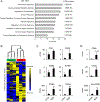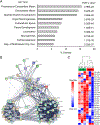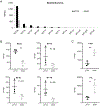Molecular pathology of adverse local tissue reaction caused by metal-on-metal implants defined by RNA-seq
- PMID: 30248488
- PMCID: PMC6428632
- DOI: 10.1016/j.ygeno.2018.09.013
Molecular pathology of adverse local tissue reaction caused by metal-on-metal implants defined by RNA-seq
Abstract
Total hip arthroplasty (THA) alleviates hip pain and improves joint function. Current implant design permits long-term survivorship of THAs, but certain metal-on-metal (MoM) articulations can portend catastrophic failure due to adverse local tissue reactions (ALTR). Here, we identified biological and molecular differences between periacetabular synovial tissues of patients with MoM THA failure undergoing revision THA compared to patients undergoing primary THA for routine osteoarthritis (OA). Analysis of tissue biopsies by RNA-sequencing (RNA-seq) revealed that MoM patient samples exhibit significantly increased expression of immune response genes but decreased expression of genes related to extracellular matrix (ECM) remodeling. Thus, interplay between local tissue inflammation and ECM degradation may account for the pathology and compromised clinical outcomes in select patients with MoM implants. We conclude that adverse responses of host tissues to implant materials result in transcriptomic modifications in patients with MoM implants that permit consideration of strategies that could mitigate ECM damage.
Keywords: Adverse local tissue reaction; Cell biology; Metal-on-metal; Metallosis; Molecular genetics; Total hip arthroplasty.
Copyright © 2018 Elsevier Inc. All rights reserved.
Conflict of interest statement
No other authors have conflicts of interest to disclosure.
Figures





References
-
- Learmonth ID, Young C, Rorabeck C, The operation of the century: total hip replacement, Lancet (London, England), 370 (2007) 1508–1519. - PubMed
-
- Pivec R, Johnson AJ, Mears SC, Mont MA, Hip arthroplasty, The Lancet, 380 (2012) 1768–1777. - PubMed
-
- Kurtz S, Ong K, Lau E, Mowat F, Halpern M, Projections of primary and revision hip and knee arthroplasty in the United States from 2005 to 2030, The Journal of bone and joint surgery American volume, 89 (2007) 780–785. - PubMed
-
- Peters CL, Erickson JA, Gililland JM, Clinical and radiographic results of 184 consecutive revision total knee arthroplasties placed with modular cementless stems, J Arthroplasty, 24 (2009) 48–53. - PubMed
-
- Eriksen J, Christensen J, Solgaard S, Schroder H, The cementless AGC 2000 knee prosthesis: 20-year results in a consecutive series, Acta Orthop Belg, 75 (2009) 225–233. - PubMed
Publication types
MeSH terms
Grants and funding
LinkOut - more resources
Full Text Sources
Other Literature Sources
Medical

